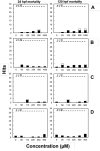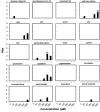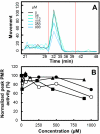Arsenic (III, V), indium (III), and gallium (III) toxicity to zebrafish embryos using a high-throughput multi-endpoint in vivo developmental and behavioral assay
- PMID: 26824274
- PMCID: PMC4754138
- DOI: 10.1016/j.chemosphere.2016.01.050
Arsenic (III, V), indium (III), and gallium (III) toxicity to zebrafish embryos using a high-throughput multi-endpoint in vivo developmental and behavioral assay
Abstract
Gallium arsenide (GaAs), indium gallium arsenide (InGaAs) and other III/V materials are finding increasing application in microelectronic components. The rising demand for III/V-based products is leading to increasing generation of effluents containing ionic species of gallium, indium, and arsenic. The ecotoxicological hazard potential of these streams is unknown. While the toxicology of arsenic is comprehensive, much less is known about the effects of In(III) and Ga(III). The embryonic zebrafish was evaluated for mortality, developmental abnormalities, and photomotor response (PMR) behavior changes associated with exposure to As(III), As(V), Ga(III), and In(III). The As(III) lowest observable effect level (LOEL) for mortality was 500 μM at 24 and 120 h post fertilization (hpf). As(V) exposure was associated with significant mortality at 63 μM. The Ga(III)-citrate LOEL was 113 μM at 24 and 120 hpf. There was no association of significant mortality over the tested range of In(III)-citrate (56-900 μM) or sodium citrate (213-3400 μM) exposures. Only As(V) resulted in significant developmental abnormalities with LOEL of 500 μM. Removal of the chorion prior to As(III) and As(V) exposure was associated with increased incidence of mortality and developmental abnormality suggesting that the chorion may normally attenuate mass uptake of these metals by the embryo. Finally, As(III), As(V), and In(III) caused PMR hypoactivity (49-69% of control PMR) at 900-1000 μM. Overall, our results represent the first characterization of multidimensional toxicity effects of III/V ions in zebrafish embryos helping to fill a significant knowledge gap, particularly in Ga(III) and In(III) toxicology.
Keywords: Arsenic; Ecotoxicity; Gallium; III/V materials; Indium; Zebrafish.
Copyright © 2016 Elsevier Ltd. All rights reserved.
Figures




Similar articles
-
Ecotoxicity assessment of ionic As(III), As(V), In(III) and Ga(III) species potentially released from novel III-V semiconductor materials.Ecotoxicol Environ Saf. 2017 Jun;140:30-36. doi: 10.1016/j.ecoenv.2017.02.029. Epub 2017 Feb 27. Ecotoxicol Environ Saf. 2017. PMID: 28231503
-
Cytotoxicity Assessment of Gallium- and Indium-Based Nanoparticles Toward Human Bronchial Epithelial Cells Using an Impedance-Based Real-Time Cell Analyzer.Int J Toxicol. 2020 May/Jun;39(3):218-231. doi: 10.1177/1091581820914255. Epub 2020 Mar 31. Int J Toxicol. 2020. PMID: 32228215
-
Toxicity of indium arsenide, gallium arsenide, and aluminium gallium arsenide.Toxicol Appl Pharmacol. 2004 Aug 1;198(3):405-11. doi: 10.1016/j.taap.2003.10.019. Toxicol Appl Pharmacol. 2004. PMID: 15276420 Review.
-
Zebrafish embryo toxicity of anaerobic biotransformation products from the insensitive munitions compound 2,4-dinitroanisole.Environ Toxicol Chem. 2016 Nov;35(11):2774-2781. doi: 10.1002/etc.3446. Epub 2016 Jun 28. Environ Toxicol Chem. 2016. PMID: 27058972 Free PMC article.
-
The toxicology of gallium oxide in comparison with gallium arsenide and indium oxide.Environ Toxicol Pharmacol. 2020 Nov;80:103437. doi: 10.1016/j.etap.2020.103437. Epub 2020 Jun 19. Environ Toxicol Pharmacol. 2020. PMID: 32565349 Review.
Cited by
-
Joint Action Toxicity of Arsenic (As) and Lead (Pb) Mixtures in Developing Zebrafish.Biomolecules. 2022 Dec 8;12(12):1833. doi: 10.3390/biom12121833. Biomolecules. 2022. PMID: 36551261 Free PMC article.
-
Cerebral Vascular Toxicity after Developmental Exposure to Arsenic (As) and Lead (Pb) Mixtures.Toxics. 2024 Aug 24;12(9):624. doi: 10.3390/toxics12090624. Toxics. 2024. PMID: 39330552 Free PMC article.
-
Teratological and Behavioral Screening of the National Toxicology Program 91-Compound Library in Zebrafish (Danio rerio).Toxicol Sci. 2019 Jan 1;167(1):77-91. doi: 10.1093/toxsci/kfy266. Toxicol Sci. 2019. PMID: 30364989 Free PMC article.
-
Developmental toxicity in zebrafish (Danio rerio) exposed to uranium: A comparison with lead, cadmium, and iron.Environ Pollut. 2021 Jan 15;269:116097. doi: 10.1016/j.envpol.2020.116097. Epub 2020 Nov 18. Environ Pollut. 2021. PMID: 33246768 Free PMC article.
-
Effects of organic and inorganic contaminants and their mixtures on metabolic health and gene expression in developmentally exposed zebrafish.bioRxiv [Preprint]. 2024 Nov 5:2024.10.28.620642. doi: 10.1101/2024.10.28.620642. bioRxiv. 2024. Update in: Environ Toxicol Chem. 2025 Jul 1;44(7):1923-1936. doi: 10.1093/etojnl/vgaf099. PMID: 39554096 Free PMC article. Updated. Preprint.
References
-
- Baranov S, Cinic B, Redwing J, Stavila V. Gallium arsenate removal from waste waters. Moldavian J. Phys. Sci. 2005;4:222–230.
-
- Brox S, Ritter AP, Kuster E, Reemtsma T. Influence of the perivitelline space on the quantification of internal concentrations of chemicals in eggs of zebrafish embryos (Danio rerio) Aquat. Toxicol. 2014;157:134–140. - PubMed
-
- Brun NR, Christen V, Furrer G, Fent K. Indium and indium tin oxide induce endoplasmic reticulum stress and oxidative stress in zebrafish (Danio rerio) Environ. Sci. Technol. 2014;48:11679–11687. - PubMed
-
- Dai Y-J, Jia Y-F, Chen N, Bian W-P, Li Q-K, Ma Y-B, Chen Y-L, Pei D-S. Zebrafish as a model system to study toxicology. Environ. Toxicol. Chem. 2014;33:11–17. - PubMed
Publication types
MeSH terms
Substances
Grants and funding
LinkOut - more resources
Full Text Sources
Other Literature Sources
Research Materials
Miscellaneous

